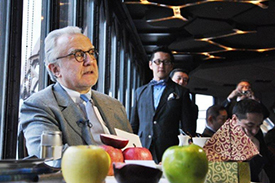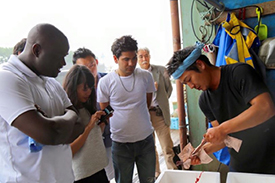Column #9
September 5, 2016

Experience Design in Japan
President and Experience Designer of XPJP Inc.
Representative Director and Social Designer of
General Incorporated Association GENKI JAPAN Kenichi Watanabe

In the Buddhist cuisine of the Three Mountains of Dewa, also called yumabushi cuisine, a large variety of dishes exist for each division of the old calendar, which is broken up into 24 sekkis and 72 kos, based on the concept of local production for local consumption. In yumabushi cuisine, not only traditional techniques of cooking, processing and storing, but also the spirit of appreciation for receiving lives to all beings are solidly incorporated even now. With organic movements such as the shift to better health, terroir and vegan taking place around the world as a backdrop, the reevaluation of the yumabushi cuisine is crossing national boundaries. Local cultures remaining in many parts of Japan in this way are being reviewed from a foreign perspective, and are being infused with new experience values. I anticipate that regional resources in Japan will be increasingly experience-designed in the future, boosted by the waves of expanding inbound tourism.
A literature titled “The Dragon and the Dazzle” was published in Italy. It introduces the concept of “Japanized Western.” That is the Japanization of the West. It is attracting attention as a research paper that studies a phenomenon that is exactly the opposite to the “Westernization of Japan.” The literature describes research studying what impacts foreign people have received and absorbed by experiencing Japanese culture. The result of the research clearly shows that generally accepted notions and invisible experience values enclosed within Japanese society itself, such as “coexistence of a wide variety of values (82.9%),” “high spiritual nature in society (56.3%)” and “the discovery of new modern (51.3%),” are exactly the characteristics of the Japanese culture.
Even now, Japan remains an aggregate of vast quantities of small local communities that have existed since ancient times. There are unique local cultural resources in each region of the national land of 380,000 km2, and the original traditional values of people living there are taking hold. The diversity in terms of lifestyle, sense of nature, history, food, clothing, festival, language and geopolitics is unprecedented anywhere in the world. Reinterpreting such values from a global perspective to make them a model for interaction as experience resources is precisely the purpose of regional revitalization under the auspices of Cool Japan.


I once produced a program to experience Japanese food culture at the Eiffel Tower, in cooperation with Alan Ducasse. Spinning the essences of Japan out of various themes such as plateware, ingredients, formal beauty and technique, I compiled them as a course while respecting the protocol of French gastronomy. I felt the real thrill of bolstering the encompassing power of Japanese culture by flexibly allowing innovations to merge with its tradition based on a foreign style, instead of forcing it upon the audience.
In another project, I was involved in developing original Arita ware tailored to the needs of many countries, in a collaboration with NOBU (Nobuyuki Matsuhisa) who operates 44 restaurants worldwide. Inheriting the technique and tradition of Arita and valuing flexible innovations at the same time, we created a number of new plateware items tailored to international requests, including sushi stand china specifically designed for California rolls, and they have begun being put into use overseas. I realized that Japan would have the opportunity to expand the arena for its activities much more widely if we engage in market-in manufacturing.
As a strategy adviser for regional revitalization/ public-private partnerships, I am now deeply involved in the Los Angeles project of JAPAN HOUSE, which is being established by the Ministry of Foreign Affairs of Japan. As an effort to explain Japan and increase the number of people who understand the country and who are friendly toward Japan, Dejima of Japan, the base of activities for the project, will be established in the United States (Hollywood,), the United Kingdom (London) and Brazil (Sao Paulo). Because JAPAN HOUSE is pursuing a plan to develop not only exhibitions and a library, but also a restaurant function where visitors can enjoy real Japanese cuisine and a product sales function for Japanese crafts and arts, it will be created as a space where visitors can encounter the varied contexts of Japan. In conjunction with a system for creators from diverse backgrounds to work together to produce projects, we are moving ahead with the development of specific projects while interacting with various local projects with local governments, local companies and designers every day. What we are always aware of when we pursue strategies to develop regional resources overseas is the need to believe in Japan’s potential for creativity.
Japan is renowned as a home to many of the world’s most venerable businesses, with 3,146 companies that have been in business for more than 200 years. This represents 56.3% of all 5,586 such companies in the world, including 837 in Germany, 222 in the Netherlands, 196 in France, two in South Korea and five in China. As for companies that have been in business for more than 100 years, 21,666 are in Japan, which also has seven companies that have been operating for more than 1,000 years. Indeed, the three world’s oldest companies are all Japanese (according to Teikoku Databank). Interestingly enough, it is said that if companies live long enough, their business creeds tend to converge. Business creeds such as “responding to changes,” “returning to the core business,” “judgment on site” and “respecting harmony” appear to be the secrets of longevity. The essence of “marketing of depth” which Japanese-style management values lies exactly at the intersection of tradition and creativity. In capitalist society, “marketing of scale” has for many years been seen as important. I believe that now is the time to show the world the potential of new industrial development with high creativity in the Japanese style. I hope to be able to bring qualitative evolution to Japan by redesigning local culture and local economies that benefit fro the sources of this power, offering a new perspective and pushing the reset switch without fearing change.


PROFILE
Kenichi Watanabe
President and Experience Designer of XPJP Inc.
Representative Director and Social Designer of General Incorporated Association GENKI JAPAN
Born in Tochigi City, Tochigi Prefecture. Graduated from Gakushuin University in 1995. Studied at the University of California, San Diego and completed the Business for International Professionals (BUSIP) certificate program at the University of Washington. Established General Incorporated Association GENKI JAPAN, a corporation specializing in regional produce, in 2010 after working for Kokusai Denshin Denwa Co., Ltd. (current KDDI), The Asahi Shimbun Company and the Regional Revitalization Bureau of Cabinet Secretariat. Established XPJP Inc. an experience design corporation, in 2015. A member of the Expert Committee of the Cool Japan Public-Private Partnership Platform of Cabinet Secretariat. The Ministry of Foreign Affairs of Japan, JAPAN HOUSE Los Angeles, Local creative and public-private partnership, Strategy adviser. Producer of the Cool Japan Project of the Ministry of Economy, Trade and Industry (2011, 2012, 2013 and 2014). Researcher at Graduate School of System Design and Management, Keio University. Producer of the Academy of Gastronomy Japan.













